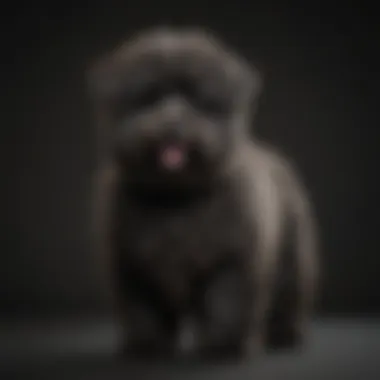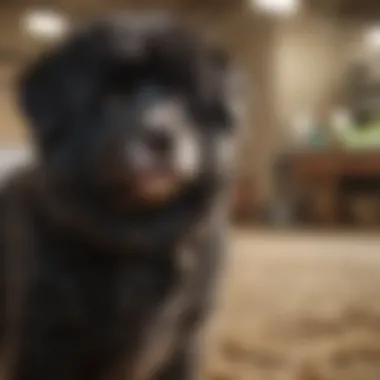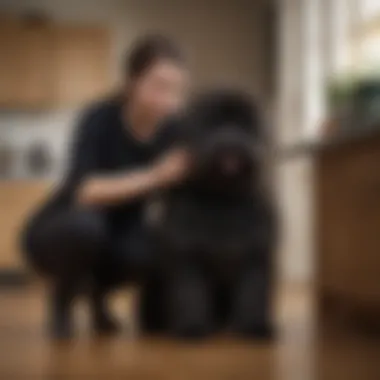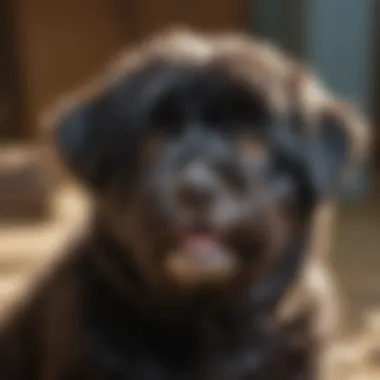Understanding Puli Dog Breeders: A Comprehensive Guide


Intro
The Puli dog is a unique and ancient breed, highly appreciated for its distinct appearance and versatile abilities. Understanding Puli dog breeders is essential for prospective owners who seek to bring this remarkable dog into their homes. This guide aims to delve into the breeding practices, characteristics, and responsibilities associated with breeding Puli dogs. Ethical breeding and health considerations will also be highlighted, ensuring that the future companionship is built on solid principles. By exploring the Puli's lineage and traits, individuals can gain insights into how to choose reputable breeders and ensure the welfare of the furry addition to their family.
Fascinating Facts About the Animal
Unique Characteristics
The Puli dog stands out with its long, corded coat that serves both aesthetic and functional purposes. This breed has an agile and athletic body, making it an excellent herder, particularly in its native Hungary. The coat is not just striking; it is water-resistant and protects the dog from harsh weather conditions. Pulis exhibit a range of coat colors, including black, white, and shades of gray, which can also influence their overall appearance and perception in breeding.
Extraordinary Abilities
Historically, Pulis have been used as herding dogs, showcasing their intelligence and agility. They have an innate ability to guard and herd livestock, which is a testament to their keen instincts and training potential. These dogs are known for their loyalty and dedication to their human companions. Pulis demonstrate a remarkable skill set, often thriving in various activities such as obedience, agility courses, and even search-and-rescue operations.
The Puli is not just a dog; it is a companion with a rich heritage and incredible abilities that reflect its storied past.
Behavior and Habitat
Natural Habitats
Pulis are adaptable and can thrive in various environments. They are best suited for spaces with ample room for exercise and exploration due to their active nature. While they originated in rural Hungary, a well-structured home can cater to their needs if urban living is the only option. Regular outdoor activities and mental stimulation are crucial for their happiness.
Social Structures
These dogs are social creatures that form strong bonds with their families. Their behavior is often influenced by early socialization and training. When properly socialized, Pulis display friendly behaviors towards other pets and humans alike. However, early exposure to various environments can help mitigate any guarding instincts they may possess.
Recent Scientific Discoveries
Latest Research Findings
Recent studies on canine genetics have provided insights into the health traits associated with various breeds, including the Puli. Understanding genetic predispositions can help breeders make informed decisions, ultimately leading to healthier dogs. Key research focuses on hereditary conditions that these dogs may face, such as hip dysplasia and eye disorders.
Breakthroughs in Animal Biology
Breakthroughs in veterinary medicine and animal biology emphasize the significance of maintaining breed standards to ensure health and viability. Breeder awareness of these advancements can enhance practices, making it possible to choose traits that better align with the breed's needs.
Cultural Significance
Animals in Folklore
The Puli dog holds a special place in Hungarian folklore, often associated with the pastoral life of herdsmen. Their presence in tales and stories highlights their historical importance as companions to working people. They symbolize loyalty and hard work in the cultural narratives surrounding them.
Influence on Art and Literature
In Hungarian art, the Puli has been depicted in various forms, reinforcing its significance as a national symbol. Writers have also referenced this breed in literature, showcasing their characteristics and qualities that resonate with readers. The Puli's distinct appearance and lineage are often celebrated in cultural expressions.
Preamble to Puli Dogs
The study of Puli dogs is significant for potential owners and breeders alike. Understanding the unique characteristics of this breed can guide decisions that promote the welfare of both the dog and its owner. This section will cover their origin, physical features, and temperament, which are vital in grasping what makes Pulis exceptional.


Origin and History
Puli dogs have a rich history that traces back to Hungary, where they were prized as herding dogs. Their lineage dates back over a thousand years, often featuring prominently in Hungarian folklore. Pulis were bred for their ability to control sheep and other livestock, showcasing traits of agility and endurance. The breed is characterized by distinctive corded coat, a feature that enables protection against harsh weather, while also serving as a aesthetic mark of their status as working dogs. As Hungary transitioned through different epochs, including the Ottoman invasion, Pulis have shown resilience and adaptation, evolving from farm companions to beloved family pets while retaining their herding instincts.
Physical Attributes
A Puli is easily recognizable due to its unique coat, which forms into long cords as they grow. These cords are water-resistant, offering protection in various conditions. A typical adult Puli ranges between 16 to 18 inches in height and weighs between 25 to 35 pounds. Their compact and muscular build allows them to execute quick movements, essential for herding activities. Pulis possess a well-proportioned body with strong legs, which complement their agile nature. Eye color can vary, but their expression is often alert and intelligent, adding to their charm as a breed. Regular grooming is necessary to maintain the cords and overall coat health.
Temperament and Behavior
Pulis are known for their loyal and protective nature. They often develop strong bonds with their families. This breed is highly intelligent and easily trainable, but also known for being somewhat independent. Early socialization is important to ensure they adapt well to different environments and people. They can be reserved around strangers, but gentle and loving with those they know. Their herding background influences their behavior significantly; they may exhibit instinctual herding tendencies with children or other pets. Understanding these aspects of their temperament is crucial for fostering a healthy relationship between the Puli and its family.
Understanding the origin, physical attributes, and temperament of Puli dogs plays a crucial role in responsible ownership and breeding practices. This knowledge lays the groundwork for the future sections of the article, which will explore breeding fundamentals and care considerations.
Puli Dog Breeding Fundamentals
Puli dog breeding is a sophisticated endeavor, requiring an understanding of various essential elements. It is not merely about producing puppies but entails ensuring that both the dogs and their future owners are well served through informed practices. Ethical breeding stands at the forefront, safeguarding the health and temperament of the breed while promoting responsible ownership. By emphasizing these fundamental concepts, this section aims to provide insight that benefits breeders, prospective owners, and the breed as a whole.
Understanding Responsible Breeding
Responsible breeding of Puli dogs involves carefully considering not just the physical traits but also the health and temperament of the breeding stock. A responsible breeder is committed to improving the breed rather than prioritizing profit. They invest time into researching lineage, ensuring there are no hereditary health concerns. It's crucial to select dogs that meet breed standards not just for physical characteristics but for behavioral aspects as well. This leads to healthier puppies who are more likely to flourish in domestic environments.
A responsible breeder is not defined by numbers but by the quality and integrity of their breeding practices.
Responsible breeding also includes making plans for every puppy. Breeders should assess potential homes to ensure compatibility with the Puli’s unique needs. This responsibility does not end with the sale; a good breeder remains a point of contact for puppy owners.
Selecting Breeding Stock
The selection of breeding stock is one of the most significant factors in Puli dog breeding. This process involves evaluating potential breeders based on their lineage, health clearances, and conformance to breed standards. Good breeding stock should not only resonate with key physical traits but should also exhibit a temperament that aligns with the breed’s characteristics.
Several aspects to consider when selecting breeding stock include:
- Health Testing: Both parents should undergo health tests for conditions prevalent in the breed.
- Genetic Diversity: Selecting dogs from diverse genetic backgrounds helps avoid inbreeding and associated health issues.
- Temperament Evaluation: The social behavior and disposition of the parents significantly influence the puppies.
Genetics and Health Testing
Genetics play a pivotal role in the success of Puli dog breeding. Understanding genetic problems and their inheritance is vital for breeders. Key health tests for this breed may include hip dysplasia evaluations and tests for eye conditions. These evaluations help breeders make informed decisions, thus mitigating the risk of passing on hereditary disorders to future generations.
Additionally, breeders should consider conducting genetic testing to identify potential carriers of inherited diseases. This conscientious approach leads to healthier puppies that are less prone to genetic issues, thus contributing to a long-lasting companionship with their future owners.
Choosing a Puli Breeder
Choosing a Puli breeder is a pivotal step for any prospective dog owner wanting to bring a Puli into their home. This decision directly influences your experience with the dog, their health, temperament, and overall well-being. A responsible breeder serves not only as a source of a new companion but also as a guide throughout your dog's life. Understanding the qualities that define a reputable breeder helps buyers make an informed choice, ensuring a positive experience.
Identifying Reputable Breeders
When seeking a Puli breeder, research is vital. A reputable breeder should demonstrate a commitment to the health and welfare of the breed. Here are some important characteristics to look for:
- Health Testing: Reputable breeders conduct health tests on their breeding stock to minimize genetic disorders. Common tests for Pulis include hip evaluations and eye screenings.
- Breeding Environment: Observe the living conditions of the dogs. A clean, spacious environment indicates a prioritize on well-being.
- Documentation: A good breeder provides documentation about the puppy's lineage and health. Ask for health clearances and pedigree.
- Experience and Knowledge: A knowledgeable breeder can discuss breed standards, traits, and potential health issues specific to Pulis.
Engaging with breeders who are active in the Puli community gives additional assurance. They often attend dog shows and participate in breed associations.


Questions to Ask Potential Breeders
Asking the right questions can provide insight into the breeder's practices and philosophy. Here are some crucial questions to consider:
- What health testing has been done? Understanding what tests have been conducted on the parents is essential for assessing potential health risks.
- Can you provide references? Talk to previous buyers to gauge their satisfaction and the health of their Pulis.
- What is the socialization process for puppies? Early socialization plays a significant role in a puppy’s development.
- What support do you offer new owners? A responsible breeder should offer guidance on care, training, and health.
These questions not only clarify typical concerns but also show the breeder’s investment in their dogs.
Red Flags in Breeding Practices
Identifying red flags can be just as vital as recognizing positive attributes. Watch for these warning signs:
- Lack of Health Testing: If a breeder hesitates or refuses to show health clearances, consider this a major concern.
- High Volume of Litters: Breeders that have excessive litters may prioritize profit over the welfare of the dogs.
- Poor Living Conditions: Unclean or unsafe environments indicate neglect and a lack of care.
- Evasive Answers: If a breeder seems uncomfortable answering questions or avoids topics crucial for dog health, it might point to irresponsible practices.
Recognizing these red flags ensures that prospective owners can avoid making a regrettable decision, promoting the health and happiness of their future Puli.
Remember, a responsible breeder values the health and happiness of the Puli above all else. It is essential to take the time to find the right match.
Puli Dog Care and Training
Caring for a Puli dog involves much more than just providing food and shelter. An understanding of their unique needs plays a critical role in ensuring their health and happiness. This section highlights essential care guidelines, effective training techniques, and the significance of socialization for Pulis. All these aspects contribute towards nurturing a well-rounded companion who thrives in a family environment.
Basic Care Guidelines
General care for Puli dogs is foundational to their well-being. These dogs require regular grooming due to their distinctive coat, which can mat easily if neglected. It is advisable to brush their fur several times a week. Bathing should occur when necessary; too frequent washing can strip essential oils from their skin, leading to irritations.
Nutrition is also critical. A balanced diet rich in protein, vitamins, and minerals is imperative. High-quality dog food should meet their active lifestyle needs. Make sure the water bowl is always filled with fresh water.
Physical exercise is another important aspect of care. Pulis are active dogs; they require daily walks, playtime, and mental stimulation. Neglecting exercise can lead to behavioral problems, such as destruction and excessive barking. One must also be aware of their health checks after a long play session, watching out for any signs of fatigue or distress.
Training Techniques for Pulis
Training Pulis demands patience and consistency. They are intelligent and responsive but can be somewhat independent-minded. Positive reinforcement techniques are particularly effective. This means rewarding desirable behaviors with treats or praise rather than using harsh corrections.
Start with basic commands like 'sit', 'stay', and 'come'. Pulis enjoy the challenge of learning new tricks. Advanced training classes can also be beneficial for honing their skills and providing them with additional socialization opportunities. Following a routine helps create stability and predictability, which is important for a Puli's learning process.
Key Training Tips:
- Use short, engaging training sessions to maintain their interest.
- Be clear and consistent with commands.
- Practice in different settings to generalize learning.
- Always end on a positive note with praise or a fun activity.
Socialization Importance
Socialization is crucial for Pulis, as it helps them develop into confident and well-adjusted dogs. Early socialization should include exposure to various people, environments, and other animals. This diverse experience allows them to learn appropriate behaviors and adapt comfortably in different situations.
Without proper socialization, Pulis can become overly wary of new experiences, leading to anxiety or aggression. Regular interactions with various stimuli can prevent these issues.
Socialization Activities Include:
- Group obedience classes.
- Visits to parks or pet-friendly areas.
- Playdates with other dogs.
- Exposure to different sounds and sights in a controlled manner.
Health Considerations for Pulis


Health considerations are crucial when it comes to Puli dogs. Understanding these aspects can ensure not only the longevity of the dog but also its quality of life. The Puli breed, with its unique physical attributes and temperament, does face certain health challenges. It becomes vital for breeders and owners alike to actively address these issues.
Common Health Issues
Pulis have some predispositions to specific health problems. Regular screening and awareness can help mitigate these risks. Common health issues within Puli include:
- Hip Dysplasia: This genetic condition can cause joint pain and mobility issues. Early detection is key to managing its effects.
- Eye Problems: Conditions like progressive retinal atrophy can occur, leading to vision loss. Regular veterinary check-ups are necessary.
- Skin Allergies: Due to their coat type, Pulis can suffer from skin irritations. Appropriate grooming practices can help minimize these issues.
- Ear Infections: The distinctive coat can trap moisture, leading to infections. Maintaining cleanliness around the ears is essential.
Awareness about these issues can lead to more informed decisions regarding breeding and care.
Preventative Health Care
Preventative health care is essential for Pulis. Regular vet visits can help catch potential issues early. Here are several recommendations:
- Routine Check-ups: Annual examinations should include blood tests and vaccinations. This helps maintain overall health.
- Dental Care: Dental hygiene is often overlooked. Regular brushing can prevent periodontal disease.
- Weight Management: Pulis can easily gain weight. Regular exercise is necessary to maintain a healthy weight.
- Vaccination and Deworming: Stay up to date with vaccinations and deworming schedules to ward off infections.
Preventative care often saves lives and reduces long-term veterinary costs.
Puli Dog Community and Support
The Puli dog community is an essential part of ensuring the well-being of these unique dogs. By connecting with other Puli owners and engaging with breed clubs and organizations, individuals can gain valuable insights. This support network offers both emotional and practical resources for current and prospective owners.
Connecting with Other Puli Owners
Building relationships with other Puli owners is crucial for several reasons. Firstly, interaction with like-minded individuals provides a platform for sharing experiences and concerns about training, health, and grooming. These conversations can help new owners understand the specific needs of their Pulis. Moreover, sharing stories strengthens the community bond.
Finding local groups, either through social media platforms like Facebook or forums on reddit.com, can foster friendships. Attending local meetups or breed-specific events creates opportunities for socialization for both people and their pets. Connections within the community can also lead to recommendations for reputable breeders and veterinarians.
Role of Puli Clubs and Organizations
Puli clubs and organizations play a significant role in supporting responsible breeding practices and helping owners connect. They often provide resources that help educate the public about the breed, its history, and characteristics. Becoming a member of such clubs can offer access to exclusive events, newsletters, and forums tailored to Puli dog owners.
Additionally, these organizations can influence standards in breeding practices. They promote ethical considerations in breeding, emphasizing health testing, responsible breeding stock selection, and creating awareness about common health issues.
In summary, engaging with the Puli dog community, both with individual owners and through dedicated clubs, provides essential support. It enriches the experience of owning a Puli and ensures the overall health and happiness of the breed.
The health and happiness of Pulis relies heavily on an informed and supportive community.
Being a part of this community can significantly enhance the experience of both new and seasoned Puli owners.
Epilogue
The conclusion serves as a pivotal section within this article, encapsulating the core themes presented throughout and underscoring the significance of ethical Puli dog breeding. As we have explored, responsible breeding is not merely about producing puppies; it encompasses a commitment to maintaining breed standards, ensuring health, and fostering a supportive community.
Summary of Key Takeaways
In reviewing the essential insights from this article, readers can recognize that:
- Puli dogs have a rich history that informs breeding practices today.
- Understanding the genetic health of breeding stock is crucial for preventing hereditary issues.
- Selecting the right breeder impacts the well-being of both the individual dog and the breed as a whole.
- Community networks and clubs play a significant role in connecting Puli owners and sharing valuable information.
Each of these points highlights different facets of breeding. When prospective owners or breeders engage with these elements, they contribute to a responsible breeding culture that values the health and temperament of Puli dogs.
The Future of Puli Breeding
Looking forward, the landscape of Puli breeding is likely to evolve in response to increased public awareness about dog welfare and health considerations. Emphasis on responsible breeding practices will continue to rise, supported by advancements in genetic testing and health screening. As dog enthusiasts and welfare organizations advocate for these practices, we could see:
- Greater transparency among breeders concerning genetic health tests.
- An increased focus on adopting from shelters and rescue organizations, promoting a wider understanding of the breed's needs.
- Collaboration among breeders, veterinarians, and dog owners to create a more informed breeding community.







